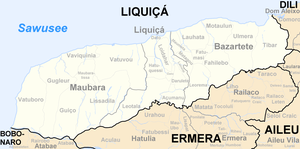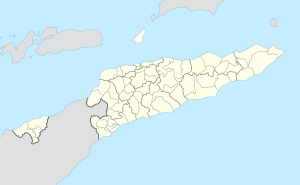Lissadila
| Lissadila | ||

|
||

|
||
| Data | ||
| surface | 59.25 km² | |
| population | 4,559 (2015) | |
| Chefe de Suco | Anselmo Fernandes (election 2009) |
|
| Aldeias | Population (2015) | |
| Bautalo | 763 | |
| Cai-Cassa | 956 | |
| Darulema | 766 | |
| Glai | 950 | |
| Lebuhae | 520 | |
| Manuquibia | 178 | |
| Nunulisa | 426 | |
|
|
||
Lissadila ( Lisadilia ) is an East Timorese Suco in the Maubara Administrative Office ( Liquiçá municipality ).
geography
| Lissadila | ||
| places | position | height |
| Cai-Cassa | 8 ° 40 ′ S , 125 ° 13 ′ E | 603 m |
| Darolema | 8 ° 40 ′ S , 125 ° 14 ′ E | 598 m |
| Esloso | 8 ° 41 ′ S , 125 ° 14 ′ E | 469 m |
| Glai | 8 ° 44 ′ S , 125 ° 12 ′ E | 0 m |
| Lebuhae | 8 ° 40 ′ S , 125 ° 14 ′ E | 453 m |
| Lisaico | 8 ° 40 ′ S , 125 ° 15 ′ E | 541 m |
| Manucibia | 8 ° 40 ′ S , 125 ° 16 ′ E | 553 m |
| Manuquibia | 8 ° 40 ′ S , 125 ° 14 ′ E | 576 m |
| Nunulisa | 8 ° 41 ′ S , 125 ° 13 ′ E | 287 m |
| Pelelo | 8 ° 41 ′ S , 125 ° 14 ′ E | 329 m |
| Siamado | 8 ° 44 ′ S , 125 ° 12 ′ E | 0 m |
| Uhiana | 8 ° 43 ′ S , 125 ° 14 ′ E | 75 m |
| Wategan | 8 ° 43 ′ S , 125 ° 13 ′ E | 22 m |
| Watubau | 8 ° 39 ′ S , 125 ° 16 ′ E | 641 m |
Before the 2015 territorial reform, Lissadila had an area of 55.14 km². Now it is 59.25 km². The Suco is located in the southeast of the Maubara administrative office. To the west is the Suco Guiço , northwest of the Suco Maubaralissa and north of the Suco Vatuvou . In the east, Lissadila borders on the administrative office Liquiçá with the Suco Leotala and in the south on the administrative office Hatulia with its Suco Aculau belonging to the municipality of Ermera . The western border is roughly followed by the rivers Surine and Dikasbata , the eastern border Dirobatelau and Gumuloa . Other rivers that arise in Suco are the Emderilua , the Bismaumate and the Kailook . All rivers flow south and end in the Gleno , which is also called Lauveli here . This is a large tributary of the Lóis .
In the northeast are the villages of Watubau , Lisaico and Manucibia and in the northwest Manuquibia , Lebuhae , Esloso , Pelelo ( Pelelor ), Nunulisa ( Nunu Lisa ), Darolema and Cai-Cassa ( Kaikasa ). In the south are the places Uhiana ( Uluana ), Wategan ( Wategas ), Glai and Siamado . Siamado has a makeshift helipad and a primary school, the Escola Primaria Siamodo .
In the Suco there are the seven Aldeias Bautalo , Cai-Cassa , Darulema , Glai , Lebuhae , Manuquibia and Nunulisa .
Residents
The Suco has 4,559 inhabitants (2015), of which 2,345 are men and 2,214 are women. The population density is 77.0 inhabitants / km². There are 749 households in the Suco. Almost 93% of the population give Tokodede as their mother tongue. Almost 6% speak Tetum Prasa and small minorities speak Mambai , Kemak and Habun .
history
In 1999, pro-Indonesian militias ( Wanra ) tried to use force to influence the mood ahead of the August 30 independence referendum . One of the most feared Wanra in East Timor, the Besi Merah Putih (BMP), comes from the village of Maubara , and was primarily forcibly recruited in this administrative office and also had its headquarters here. Many people fled for fear of the forced recruitment. The BMP was already active from January 1999. She committed hundreds of crimes before the referendum and after the independence decision was announced. Lissadila, Vatuvou and Maubaralissa became ghost towns . Its residents fled to Sare (Ermera municipality). Up to 6000 refugees gathered there alone (2250 from Guiço alone) and stayed until the INTERFET arrived in September 1999. 375 refugees came to the Carmelite nuns in Lissadila.
politics
In the elections of 2004/2005 was Anselmo Fernandes elected Chefe de Suco and in 2009 re-elected.
economy
There is a small production of toilets in the village. They are poured from concrete.
Web links
- Results of the 2010 census for the Suco Lissadila ( tetum ; PDF; 8.2 MB)
- Results of the 2015 census for the Suco Lissadila (tetum; PDF)
- Seeds of Life: Suco information sheets Maubara (tetum)
Individual evidence
- ↑ a b c d Direcção-Geral de Estatística : Results of the 2015 census , accessed on November 23, 2016.
- ↑ Fallingrain.com: Directory of Cities, Towns, and Regions in East Timor
- ↑ Direcção Nacional de Estatística: Population Distribution by Administrative Areas Volume 2 English ( Memento of the original from January 5, 2017 in the Internet Archive ) Info: The archive link has been inserted automatically and has not yet been checked. Please check the original and archive link according to the instructions and then remove this notice. (2010 census; PDF; 22.6 MB)
- ^ Timor-Leste GIS-Portal ( Memento from June 30, 2007 in the Internet Archive )
- ↑ List of polling stations for the parliamentary elections in East Timor 2007 (PDF file; 118 kB)
- ↑ UNMIT: Timor-Leste District Atlas version 02, August 2008 ( Memento of the original from December 3, 2011 in the Internet Archive ) Info: The archive link has been inserted automatically and has not yet been checked. Please check the original and archive link according to the instructions and then remove this notice. (PDF; 486 kB)
- ↑ Jornal da Républica with the Diploma Ministerial n. 199/09 ( Memento of February 3, 2010 in the Internet Archive ) (Portuguese; PDF; 323 kB)
- ↑ Results of the 2010 census for the Suco Lissadila ( tetum ; PDF; 8.2 MB)
- ↑ "Chapter 7.3 Forced Displacement and Famine" ( Memento of the original from November 28, 2015 in the Internet Archive ) Info: The archive link was inserted automatically and has not yet been checked. Please check the original and archive link according to the instructions and then remove this notice. (PDF; 1.3 MB) from the "Chega!" Report by CAVR (English)
- ↑ Secretariado Técnico de Administração Eleitoral STAE: Eleições para Liderança Comunitária 2004/2005 - Resultados ( Memento of August 4, 2010 in the Internet Archive )
- ↑ Secretariado Técnico de Administração Eleitoral STAE: Eleições para Liderança Comunitária 2009 - Resultados ( Memento of August 4, 2010 in the Internet Archive )


